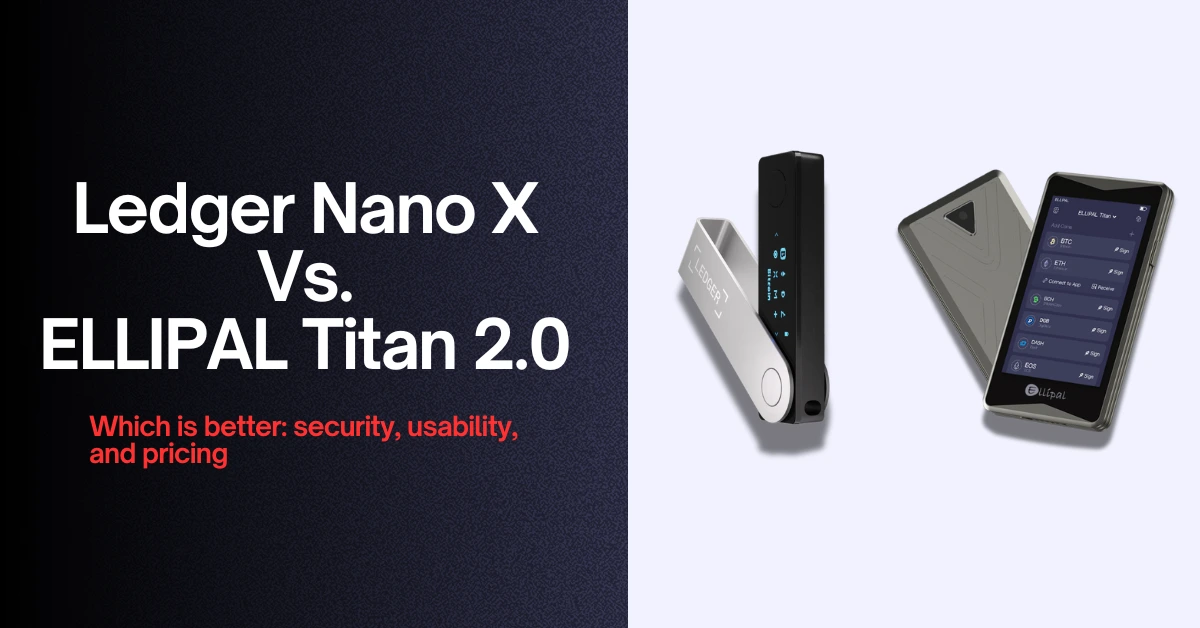I have been using Ledger Nano X and ELLIPAL Titan 2.0 for a while. I’ve literally put them head-to-head in different real-world scenarios to see how they perform for various purposes you might have.
Now, both of these crypto hardware wallets were tested by me for their crypto storage capabilities, how they stack up against various security threats, their ability to manage NFTs and staking, which one is easier and more user-friendly, and to see which one is better, Bluetooth or QR code communication.
But first, here’s a quick Ledger versus ELLIPAL Titan comparison, focusing on the basic similarities and differences between both cold wallets:
| Feature | Ledger Nano X | ELLIPAL Titan 2.0 |
| Type of Wallet | Hardware wallet | air-gapped cold wallet |
| Dimensions | 72mm x 18.6mm x 11.75mm | 118mm × 66mm × 9.7mm |
| Weight | 34g | 140g |
| Body Material | Brushed stainless steel and plastic | Full metal-sealed aluminum alloy |
| Screen Type & Size | 128×64 px OLED, monochrome | 4-inch Full Lamination IPS Color Touchscreen (1280×720 pixels on 2.0) |
| Connectivity | USB-C, Bluetooth® | QR Scanner (100% Air-gapped – No Wi-Fi, Bluetooth, USB, or Networks) |
| Security Chip | CC EAL5+ certified Secure Element (ST33J2M0) | CC EAL5+ certified Secure Element |
| Physical Security | Standard casing | Full metal-sealed, Anti-disassembly & Anti-tamper design |
| Battery Life (Rated) | (100 mAh) Up to 8 hours in standby, 3-4 hours in use (approx.) | 1400 mAh (Weeks in use) |
| Supported Crypto Assets | 5,500+ coins and tokens | 10,000+ coins and tokens across 50+ blockchains |
| NFT Support | Yes, via Ledger Live (primarily Ethereum & Polygon) | Yes, primarily Ethereum, Solana, Bitcoin, and more chains |
| Companion App | Via USB connection to the computer with Ledger Live | ELLIPAL App (Smartphone only – iOS/Android) |
| Firmware Updates | Via USB connection to computer with Ledger Live | Offline via MicroSD Card |
| Price (USD) | ~$149 (approx.) | ~$129 (approx.) |
| Seed Phrase Support | 24-word Secret Recovery Phrase | 12-word, 24-word & Passphrase (BIP39 compatible) |
| Open Source | BOLOS (Proprietary OS), some components (partial) | Partially open-source (frameworks, JS-Lib), core firmware is not fully open |
| Account Management | Install up to 100 apps (in practice, 10 apps) | Up to 10 multiple accounts, Secret Secondary Wallet Option, Unlimited coin storage |
| Tamper Detection | No specific self-destruct | Auto-self-destruct upon detected tampering, PCI Level Self-Destruction |
Why I Switched from Ledger Nano X to ELLIPAL Titan 2.0?
For a long time, I have been using Ledger Nano X. It’s compact, fairly easy to use with the Ledger Live app, and supports a ton of coins, over 5,500 actually. Plus, it has Bluetooth, which is super convenient for managing digital assets.
But then, one day, came the whole “Ledger Recover” thing in 2023. While Ledger assured us our private keys were safe, the idea that a firmware update could potentially make them recoverable by a third party, even if it’s opt-in, really rattled my confidence. For me, the whole point of a hardware wallet is absolute self-custody and isolation.
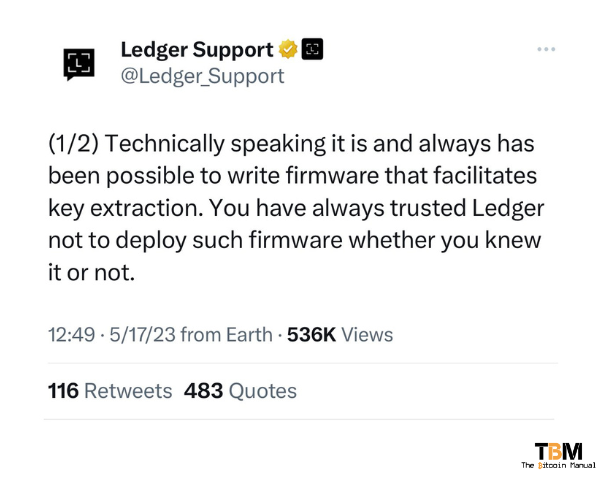
That day, I decided to switch from Ledger Nano X to ELLIPAL Titan 2.0. Now, this firmware update and Ledger Recover saga were not the only reasons. Low storage, Bluetooth issues, data leaks, battery doesn’t last long, and most importantly very small screen. Add these all as well.
ELLIPAL Titan 2.0 is 100% air-gapped. This thing has no USB, no Bluetooth, and no Wi-Fi. It’s completely offline. Hence, all your transactions are done by scanning QR codes between the device and its mobile app. The physical build is also impressive; it’s a solid, metal-sealed body that’s tamper-proof.
It also has a larger, 4-inch touchscreen, which is way easier to navigate than the tiny screen and two buttons on the Nano X. And, it supports over 10,000 cryptocurrencies natively, without needing to install specific apps like Ledger does, which means no storage limitations for coin apps.
For me, the air-gapped security, unlimited storage, and large touchscreen display made the switch to ELLIPAL Titan 2.0 a no-brainer.
One negative point I used to dislike about legacy ELLIPAL wallet was its security chip, but now with the 2.0 version, they have also added a CC EAL5+ secure element chip.
Before moving to a detailed comparison between Ledger and ELLIPAL, let’ see their pros and cons:
Security-wise: ELLIPAL is Better
As discussed above, ELLIPAL Titan 2.0 is air-gapped without WiFi, Bluetooth, NFC, or cable. Seriously, none. All transactions are initiated and then confirmed by scanning QR codes.
First, you need to generate a transaction on your phone app, the app creates a QR code, you scan it with the ELLIPAL, the ELLIPAL signs it offline, then it generates another QR code that you scan back with the app to broadcast the transaction.
And hence, your private keys literally never touch an online connection.
Now, let’s talk about the Ledger Nano X. It has both Bluetooth and a USB connection. And that’s the issue or a warning sign!
First, Bluetooth connectivity. Ledger states that only public data is transmitted via Bluetooth and that private keys never leave the Secure Element. Also, they have security measures like numeric comparison for pairing.
However, the very existence of a Bluetooth connection, even if theoretically secure, introduces an attack surface that an air-gapped device simply doesn’t have. And again, there have been discussions and concerns around Bluetooth protocol vulnerabilities, and even if Ledger mitigates them well, the possibility of a sophisticated attack, even a man-in-the-middle scenario, is something I prefer to avoid entirely when it comes to my crypto.
Of course, why introduce that potential vector if you don’t have to?
Second, USB and firmware upgrades. Ledger Nano X requires a USB connection to a computer for firmware updates and, often, for initial setup and managing certain coin apps. This means you’re connecting your hardware wallet to an online device that could potentially be compromised by malware.
So, yes, Ledger Live is designed to be secure and verifies firmware integrity, but the fact that the wallet needs to be plugged into an internet-connected computer for these crucial operations is a point of vulnerability.
With the ELLIPAL Titan 2.0, even firmware updates are done offline via a microSD card.
Then there’s the Ledger Recover debacle of 2023. This was a huge blow to my trust. The idea that a firmware update could allow for the extraction of my seed phrase, even if it was an opt-in service, fundamentally challenged the core principle of a hardware cryptocurrency wallet.

At last, about ELLIPAL Titan 2.0 Security features:
- Completely Air-Gapped
- CC EAL5+ Certified Secure Element
- Protection from Physical Attacks (Anti-Tamper/Anti-Disassembly)
- Automatic Self-Destruct Mechanism
- Offline Firmware Updates (via MicroSD Card)
- 24-Word Mnemonic and 25th Passphrase Support
- Secret Secondary Wallet Option
Ledger Nano X vs. ELLIPAL Titan 2.0: My Honest Comparison
Design
The Ledger Nano X is quite compact, measuring around 72mm x 18.6mm x 11.75mm and weighing just 34 grams. It’s got that sleek, USB-stick-like design, made from a mix of brushed stainless steel and plastic. It fits easily in your pocket.
It has a small screen (128×64 pixels, to be exact) and two buttons on the top. The USB-C port is at one end, and it also has Bluetooth for connecting to your phone. It feels pretty durable for its size.
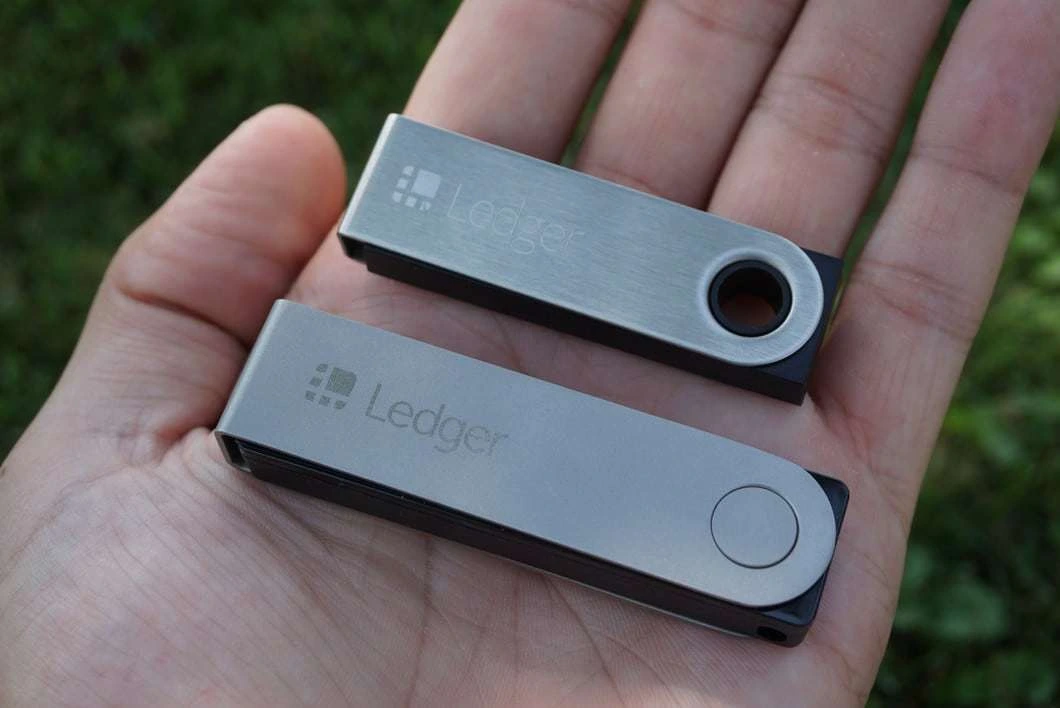
Now, the ELLIPAL Titan 2.0 is different. It’s much larger, more like a small smartphone. I am talking about 118mm x 66mm x 9.7mm, and it weighs around 140 grams.
It has a full metal-sealed body made from aluminum alloy, which feels incredibly solid and premium. This thing is built like a tank.
Here, the biggest design difference I found is its 4-inch full lamination IPS color touchscreen (with a resolution of 1280×720 pixels on the 2.0 model), which is way bigger than the Nano X’s tiny screen.

It doesn’t have any physical ports for USB, Bluetooth, or Wi-Fi; everything is done via a camera on the back for scanning QR codes. The physical tamper-proof design is part of its look; it’s designed so you literally can’t open it without it self-destructing.
| Feature | Ledger Nano X | ELLIPAL Titan 2.0 |
| Dimensions | Approx. 72mm x 18.6mm x 11.75mm | Approx. 118mm x 66mm x 9.7mm |
| Weight | 34 grams | 140 grams |
| Body Material | Brushed stainless steel and plastic | Full metal-sealed aluminum alloy |
| Screen | Small (128×64 pixels) OLED, monochrome | Large (4-inch, 1280×720 pixels) IPS touchscreen |
| Input Method | 2 physical buttons | Touchscreen |
| Connectivity | USB-C, Bluetooth | None (Air-gapped) |
| Feel | Compact, like a USB stick | Solid, premium, like a mini-smartphone |
Cryptocurrency and NFT Support
The Ledger Nano X supports over 5,500 coins and tokens. All the big ones like Bitcoin (BTC), Ethereum (ETH), XRP, Cardano (ADA), Solana (SOL), and basically all ERC-20 tokens.
You can also manage NFTs through the Ledger Live app. But, the worst part, only Ethereum and Polygon NFTs are natively supported. For let’s say Solana NFTs, you need to use third-party crypto wallets.
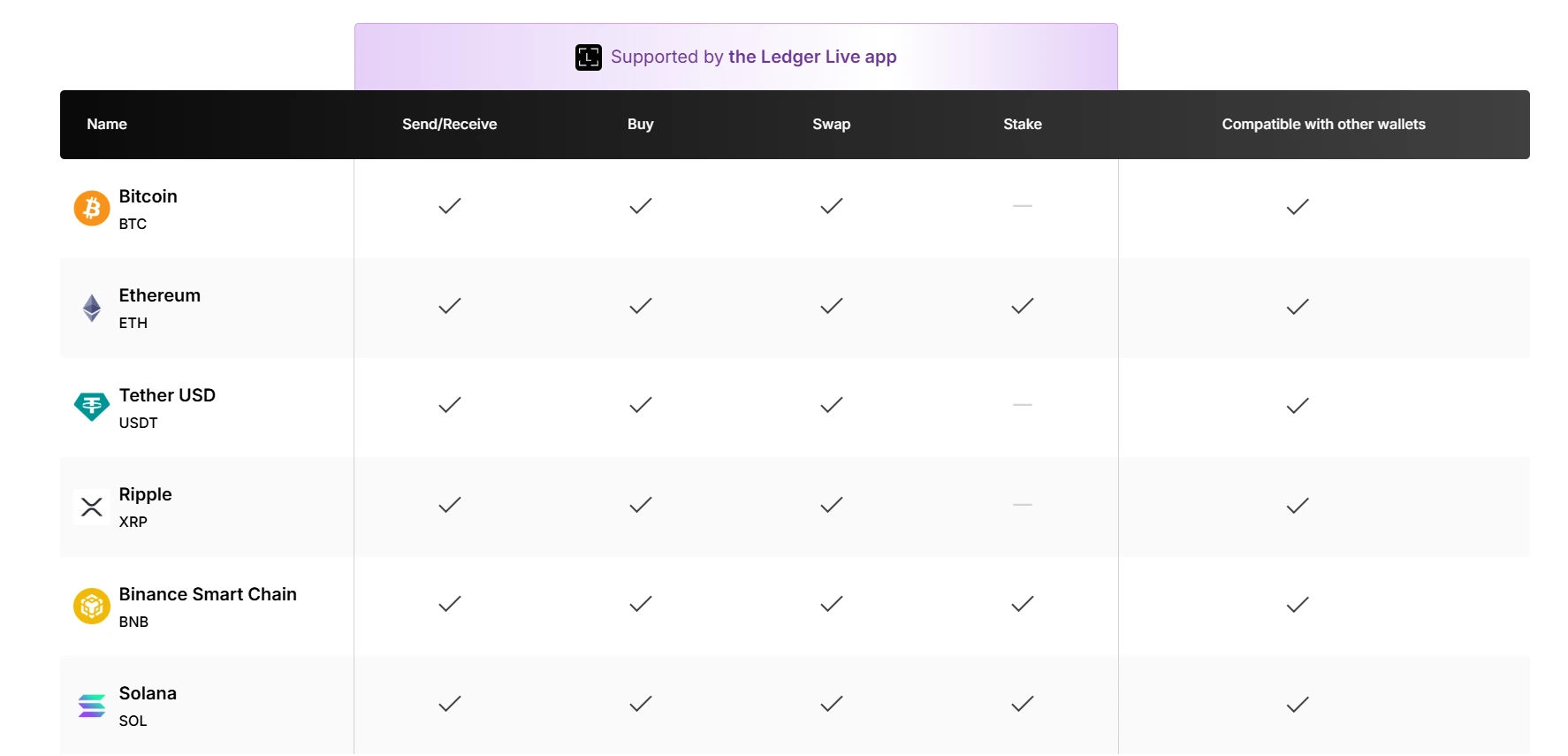
The thing is, to manage different coins, I often need to install specific applications on the device itself. While the Nano X has more storage than its older brother, the Nano S Plus (still, it’s 2 MB), you might still hit a limit on how many apps you can have installed at once if you are holding a very diverse portfolio.
You might have to uninstall an app to make space for another, which isn’t a huge deal but can be a small inconvenience sometimes.
The ELLIPAL Titan 2.0 actually supports more coins than Ledger. It supports over 10,000 coins and tokens across more than 50 blockchains. The great part, which I really appreciate, is that it supports them natively, meaning you don’t have to install individual apps for each coin like you do on Ledger.
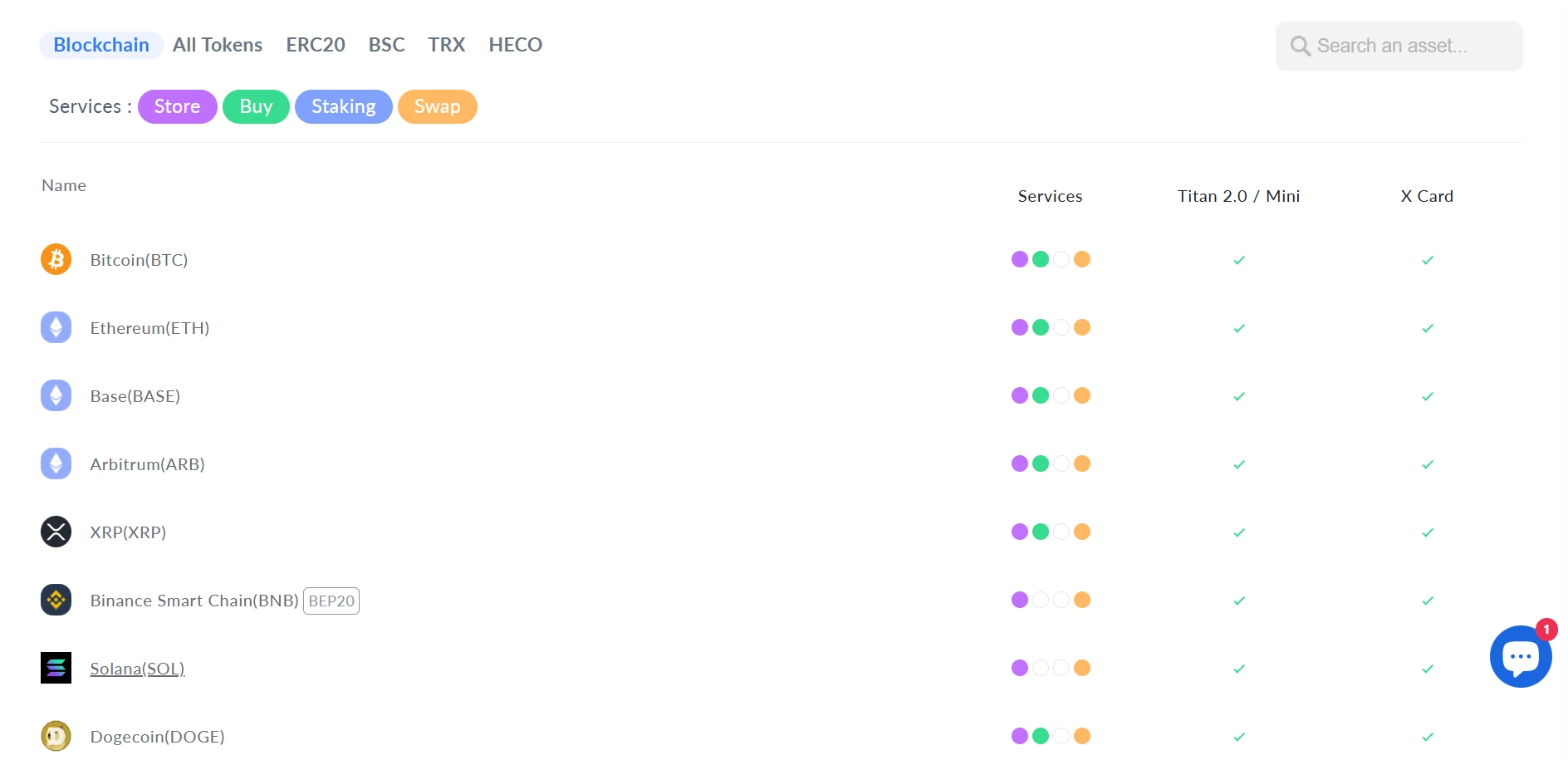
For NFTs, it supports Ethereum, Polygon, Solana, Bitcoin, and many more blockchains. So, if you don’t want to worry about app storage limits, I think the ELLIPAL has a slight edge here.
| Feature | Ledger Nano X | ELLIPAL Titan 2.0 |
| Supported Crypto | 5,500+ coins and tokens | 10,000+ coins and tokens |
| Blockchains | 25+ blockchains | 50+ blockchains |
| App Installation | Requires installing specific apps per coin | Native support, no app installation per coin needed |
| NFT Support | Yes, via Ledger Live | Yes, primarily Ethereum & Polygon NFTs only |
| Storage Limitations | Limited app storage (2 MB) | Unlimited coin storage (no per-coin apps) |
Price
The Ledger Nano X typically costs around $149 in the United States. Prices can vary a bit depending on where you buy it and any ongoing sales, but that’s the general range I’ve seen.
The ELLIPAL Titan 2.0 usually falls in a similar price range, often around $129 (though I’ve seen it listed for around $149 USD on official sites, which converts to a bit more).
Also, I’ve seen deals or bundles that include accessories like the Seed Phrase Steel backup, which might slightly change the overall cost. So, when I compare just the device prices, I find them quite competitive, both sitting in that premium crypto hardware wallet segment.
Usability
The Ledger Nano X relies heavily on the Ledger Live companion app, and you can use it on desktop and mobile (iOS and Android).
The device itself has a small screen and two buttons. I use these buttons to scroll through options and confirm transactions. It’s pretty straightforward once you get the hang of it, but it can feel a bit clunky to you, especially for longer addresses or details.
The Bluetooth connection for mobile use is a big plus for convenience; I can manage my crypto on the go without needing a cable. Also, the setup process is guided by Ledger Live, which I found quite user-friendly.
The ELLIPAL Titan 2.0, with its large 4-inch touchscreen, feels much more like using a smartphone to me. Swiping and tapping are natural, and viewing transaction details, addresses, and even portfolio balances directly on the device is a much clearer experience.
It connects to its own ELLIPAL app on your smartphone, but, and this is key, it uses only QR codes for all communication, as discussed before in detail.
I scan a QR code from my phone app to the ELLIPAL to send transaction details, then the ELLIPAL processes it offline and shows a new QR code that I scan back with my phone to broadcast the signed transaction.
It’s obviously a few extra steps compared to Ledger’s Bluetooth, but for me, that added security of being truly air-gapped is absolutely worth it.
Hence, for daily viewing and approving on the device itself, I find the ELLIPAL’s large touchscreen makes it much more user-friendly compared to Ledger Nano X.
Does ELLIPAL Offer Bluetooth Connectivity Similar to Ledger?
No, it doesn’t. The whole design philosophy behind the ELLIPAL Titan 2.0 is to be completely “air-gapped.” It has absolutely no way to connect to the internet or any other device wirelessly or with a cable. No Wi-Fi, no USB port for data transfer, and most importantly for this question, no Bluetooth.
Which Should You Choose, ELLIPAL or Ledger?
I think you should choose the ELLIPAL Titan 2.0 if maximum security and being completely offline are your absolute top priorities. Its air-gapped design is absolutely top-notch. But again, due to QR code signing, you’ll find it’s a bit less convenient for quick transactions, but maybe that added security is worth it.
Now, you should consider the Ledger Nano X if convenience and ease of use. It’s really good when you’re managing your crypto on the go with your phone. Its Bluetooth connection is super handy, and I find the Ledger Live app really straightforward to use.
You can also read my honest Ledger Nano X wallet review….
So, here is the final verdict on Ledger Nano X vs. ELLIPAL Titan 2.0…
You should buy ELLIPAL Titan 2.0 for
- Air-gapped crypto wallet
- Large touchscreen display
- Not an everyday user (since QR code scanning can be a pain in the…)
You should buy Ledger Nano X for
- Bluetooth connectivity
- Best mobile and desktop app
- Native Ethereum chain staking support
- Highly popular among crypto users (trusted by 10M+ users)
